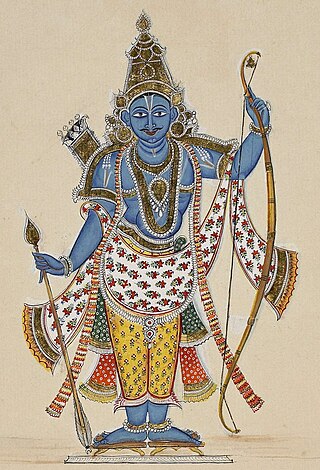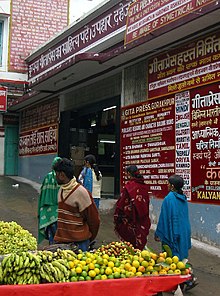
Rambola Dubey, known as Tulsidas, was a Vaishnava (Ramanandi) Hindu saint and poet, renowned for his devotion to the deity Rama. He wrote several popular works in Sanskrit, Awadhi, and Braj Bhasha, but is best known as the author of the Hanuman Chalisa and of the epic Ramcharitmanas, a retelling of the Sanskrit Ramayana, based on Rama's life, in the vernacular Awadhi language.

Dattatreya, Dattā or Dattaguru, is a paradigmatic Sannyasi (monk) and one of the lords of yoga, venerated as a Hindu god. He is considered to be an avatar and combined form of the three Hindu gods Brahma, Vishnu, and Shiva, who are also collectively known as the Trimurti, and as the manifestation of Parabrahma, the supreme being, in texts such as the Bhagavata Purana, the Markandeya Purana, and the Brahmanda Purana, though stories about his birth and origin vary from text to text. Several Upanishads are dedicated to him, as are texts of the Vedanta-Yoga tradition in Hinduism. One of the most important texts of Hinduism, namely Avadhuta Gita is attributed to Dattatreya. Over time, Dattatreya has inspired many monastic movements in Shaivism, Vaishnavism, and Shaktism, particularly in the Deccan region of India, Maharashtra, Gujarat, Madhya Pradesh, Rajasthan and Himalayan regions where Shaivism is prevalent. His pursuit of simple life, kindness to all, sharing of his knowledge and the meaning of life during his travels is reverentially mentioned in the poems by Tukaram, a saint-poet of the Bhakti movement.

Ramcharitmanas, is an epic poem in the Awadhi language, based on the Ramayana, and composed by the 16th-century Indian bhakti poet Tulsidas. This work is also called, in popular parlance, Tulsi Ramayana, Tulsikrit Ramayana, Tulsidas Ramayana or simply Manas. The word Ramcharitmanas literally means "Lake of the deeds of Rama". It is considered one of the greatest works of Hindu literature. The work has variously been acclaimed as "the living sum of Indian culture", "the tallest tree in the magic garden of medieval Indian poetry", "the greatest book of all devotional literature" and "the best and most trustworthy guide to the popular living faith of the Indian people".
Ratangarh is a town and Tehsil of the Churu district in Rajasthan, India. Ratangarh was previously called Kolasar. It is famous for grand havelis (mansions) with frescoes, which is an architectural specialty of the Shekhawati region. Ratangarh is also famous for its handicraft work.

Ashtavakra is a revered Vedic sage in Hinduism. His name literally means "eight deformities", reflecting the eight physical deformities he was born with. His maternal grandfather was the Vedic sage Aruni, his parents were both Vedic students at Aruni's school. Ashtavakra studied, became a sage and a celebrated character of the Hindu Itihasa epics and Puranas.

The Hanuman Chalisa is a Hindu devotional hymn (stotra) in praise of Hanuman. It is an Awadhi language text attributed to Tulsidas, and is his best known text apart from the Ramcharitmanas. The word "chālīsā" is derived from "chālīs", which means the number forty in Hindi, as the Hanuman Chalisa has 40 verses.

Bharata is a figure in the ancient Hindu epic Ramayana. He is the son of Dasharatha, the king of Kosala, and Kaikeyi, the daughter of King Ashvapati of Kekeya. He is a younger half-brother of Rama. He rules Ayodhya as its regent while Rama is banished from his kingdom, and fights to rescue his wife Sita, kidnapped by Ravana.

Adhyatma Ramayana is a 13th- to 15th-century Sanskrit text that allegorically interprets the story of Hindu epic Ramayana in the Advaita Vedanta framework. It is embedded in the latter portion of Brahmānda Purana, and the author is considered to be Vyasa. The Hindu tradition also attributes the text to the Bhakti movement saint Ramananda.

Sankat Mochan Hanuman Temple is a Hindu temple in Varanasi, Uttar Pradesh, India and is dedicated to the Hindu God Hanuman. The temple was established by famous Hindu preacher and poet saint Sri Goswami Tulsidas in the early 16th century and is situated on the banks of the Assi river. The deity was named "Sankat Mochan" meaning the "reliever from troubles".

Ramlila is any dramatic folk re-enactment of the life of Rama according to the ancient Hindu epic Ramayana or secondary literature based on it such as the Ramcharitmanas. It particularly refers to the thousands of the Hindu god Rama-related dramatic plays and dance events, that are staged during the annual autumn festival of Navaratri in India. After the enactment of the legendary war between good and evil, the Ramlila celebrations climax in the Vijayadashami (Dussehra) night festivities where the giant grotesque effigies of evil such as of the rakshasa (demon) Ravana are burnt, typically with fireworks.

Hanuman Prasad Poddar (1892–1971) was an Indian independence activist, littérateur, magazine editor and philanthropist. He was the founding editor of the spiritual magazine, Kalyan which was published by Gita Press setup by Ghanshyam Jalan and Jay Dayal ji Goeyendka. His work in fostering pride among the people regarding India's history and philosophic tradition earned him praise from Mahatma Gandhi. He was affectionally called "Bhai Ji" or "Lovingly Brother". The Government of India issued a postage stamp in his memory in 1992.
The Institute of Advanced Studies in Education (IASE) is a deemed university in Sardarshahar, Rajasthan, India. The university is accredited as a "B+" institute by the NAAC.it is located in Churu District of Rajasthan.Iase is a deemed university recognised by ugc under section u/s 3 of ugc act-1956vide notification by MHRD no f.9-29/2000-u.3.Govt.of India. iase university is affiliated by govt.of India, MHRD notification on declaring the institute as Deemed to be University under f.9-6/81-u.3 dated 25 October 1983. IASE University's registrar is Dr.Dharm Singh Gehlot.

Rama is a major deity in Hinduism. He is the seventh and one of the most popular avatars of Vishnu. In Rama-centric traditions of Hinduism, he is considered the Supreme Being.

Jagadguru Ramanandacharya Swami Rambhadracharya is an Indian Hindu spiritual leader, educator, Sanskrit scholar, polyglot, poet, author, textual commentator, philosopher, composer, singer, playwright and Katha artist based in Chitrakoot, India. He is one of four incumbent Jagadguru Ramanandacharya, and has held this title since 1988.
Tulsi Peeth Seva Nyas is an Indian religious and social service institution based at Janki Kund, Chitrakoot, Madhya Pradesh, India. It was established by the Hindu religious leader Jagadguru Rambhadracharya on August 2, 1987. Rambhadracharya believes that this Peeth is situated at the place where the Hindu god Rama gave his sandals to his brother Bharat.

This timeline lists important events relevant to the life of the Vaishnava (Hindu) spiritual leader, poet, commentator, educationist, religious and social figure Rambhadracharya.

Araṇya-Kāṇḍa, or The Forest Episode, is the third book of the epic poem of Ramayana. It is also found in the Rāmcharitmānas. It follows the legend of Rama through his fourteen-year exile in the forest, joined by his wife and his brother. Rama overcomes challenges and demons by upholding standards of behavior. Nearing the end of his exile, Rama's wife Sita is kidnapped by the king Ravana, and Rama learns what happened. The story continues in the next book, Kiśkindhā Kāṇḍ.

Pundit Devarshi Ramanath Shastri was a Sanskrit poet, scholar and commentator on Pushtimarg and Shuddhadvaita Vedanta, the philosophical school of pure non-dualism propounded by Shri Vallabhacharya (1479-1531). He was born in 1878 in Jaipur, Rajasthan in a renowned Vellanadu Brahmin family of Sanskrit scholars belonging to the Taittariya branch of Krishna Yajurveda, who migrated from Andhra Pradesh to North India in the 15th century AD and to Jaipur in the 18th century with his famous ancestor Kavikalanidhi Devarshi Shrikrishna Bhatt having been invited by Sawai Jai Singh II. His father’s name was Shri Dwarakanath Bhatt and mother’s name was Shrimati Janaki Devi. His only son was Devarshi Brajnath Shastri (1901-1954), who was also a scholar of Shuddhadvaita. He was the elder brother of epoch-making Sanskrit poet and scholar Bhatt Mathuranath Shastri. He wrote extensively in Hindi, Sanskrit and Brajbhasha languages.

Sri Venkateswar Steam Press is one of the oldest publishers in India.

The Valmiki Samhita is a Sanskrit text of six chapters. It comes under the Narada Panchratra. The Valmiki Samhita is attributed to the worship of Rama and Sita. It describes them to be the utmost reality.




















